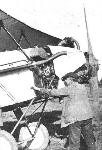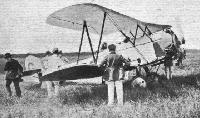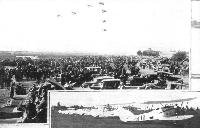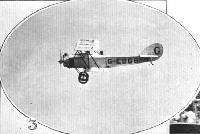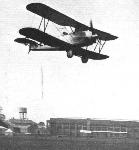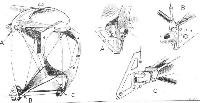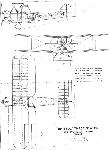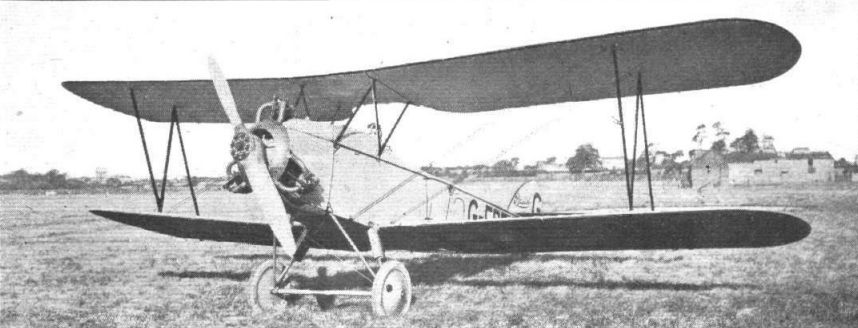
Jane's Encyclopedia of Aviation
Bristol Taxiplane and Trainer (UK)
The Taxiplane and the Trainer were basically the same aircraft, the former accommodating a pilot forward and two passengers side-by-side aft and the Trainer two in tandem. Power for both was an 89.4 kW (120 hp) Bristol Lucifer engine. Only three Taxiplanes were built, but 24 Trainers were produced for use at the Bristol RAF Reserve Officers’ Flying School, and for export to Chile, Bulgaria and Hungary.
Описание:
- Jane's Encyclopedia of Aviation
- Flight, December 1922
THE "BRISTOL" THREE-SEATER, 100 H.P. BRISTOL LUCIFER ENGINE - Flight, July 1923
THE "BRISTOL" LUCIFER SCHOOL MACHINE
Фотографии
-
Flight 1922-12 / Flight
THE "BRISTOL" THREE-SEATER: Three-quarter front view.
-
Flight 1939-03 / Flight
The Lucifer Trainer of 1923. It was sold to several countries.
-
Flight 1940-02 / Flight
The school machine of 1921 was fitted with the 3-cyl. Lucifer engine.
-
Flight 1922-12 / Flight
Регистрационный номер: G-EBEW [2] THE "BRISTOL" THREE-SEATER: Three-quarter rear view.
-
Jane's All the World Aircraft 1980 / Encyclopedia of Aviation - Aircraft A-Z - v2
Регистрационный номер: G-EBEY Bristol Taxiplane.
-
Flight 1922-12 / Flight
THE "BRISTOL" THREE-SEATER: Front view. |The man standing in front gives a good idea of the size of the machine.
-
Flight 1922-12 / Flight
THE "BRISTOL" THREE-SEATER: View showing how engine mounting is swung out to give access to back of engine.
-
Aviation Historian 1 / P.Jarrett - Under the windstocking
Регистрационный номер: G-EBEW [2] Taxiplane G-EBEW was the first of its type, intended as an economical three-seat general utility aeroplane using the Bristol Aeroplane Co’s 100 h.p. Lucifer three-cylinder radial engine. However, when it was tested at the Aeroplane & Armament Experimental Establishment at Martlesham Heath in April 1923 it proved to be overweight with two passengers in the rear cockpit, and therefore could only be certificated as a two-seater. Consequently only two more were built. This machine was scrapped in July 1925.
-
Flight 1923-06 / Flight
THE GROSVENOR CHALLENGE CUP: On the left, C. F. Uwins about to start on Sir Henry White-Smith's Bristol "Taxi-'plane" (100 h.p. Bristol "Lucifer"), after having set his watch to official time.
-
Flight 1923-07 / Flight
Регистрационный номер: G-EBFZ The "Bristol" Lucifer School Machine: Side view
-
Aeroplane Monthly 1982-07 / P.Capon - Capon's Corner
Регистрационный номер: G-EBGE Bristol Type 83B Lucifer G-EBGE photographed at Stag Lane in June 1925. This attractive aircraft was powered by a 120 h.p. Bristol Lucifer IV engine and was owned by the Bristol Aeroplane Company from 1923 until it was scrapped in 1931.
-
Flight 1923-07 / Flight
The "Bristol" Lucifer School Machine: Three-quarter front view.
-
Flight 1924-05 / Flight
A row of "Bristol" school machines, fitted with three-cylinder Bristol "Lucifer" engines.
-
Flight 1925-08 / Flight
Регистрационный номер: G-EBGD [2] SOME OF THE LARGER MACHINES AT LYMPNE: From left to right, the Avro-Lynx, Bristol "Lucifer," Bristol "Bloodhound," S.E.5, Sopwith "Gnu," A.D.C.l, and a sky-writing S.E.5.
Другие самолёты на фотографии: Avro Avro 504N - Великобритания - 1920Bristol Bloodhound / Type 84 - Великобритания - 1923Martinsyde A.D.C.1 / Nimbus - Великобритания - 1924RAF S.E.5 - Великобритания - 1916Sopwith Gnu - Великобритания - 1919
-
Flight 1926-12 / Flight
BRISTOLS IN CHILE: For some time past the Chilian Air Force has been employing a number of Bristol-Lucifer School machines with highly successful results - both as regards machine and engine. We show above a picture of a formation of seven of these Bristol-Lucifer 'buses at an Air Display held last September at El Bosque Aerodrome, near Santiago. Below, the seven machines are shown lined up on the aerodrome.
-
Flight 1927-06 / Flight
Регистрационный номер: G-EBGB THE BRISTOL FLYING .MEETING: 3, Mr. Campbell, on the "Bristol-Lucifer" training machine.
-
Flight 1928-05 / Flight
Winning the Talbot O'Farrell Race: Mr. Uwins crossing the finishing line on his Bristol "P.T.M." biplane with Bristol "Lucifer" engine. His average speed was 109 m.p.h.
-
Flight 1928-07 / Flight
SOME MORE COMPETING MACHINES: The Bristol 83E (Bristol "Titan I") piloted by Sqdn.-Leader A. G. Jones-Williams. The "Bristol" training machine is fitted with the new "Titan" engine, which is composed in the main of "Jupiter" parts, and has five "Jupiter" cylinders.
-
Aeroplane Monthly 1979-12 / Heston /Gone but not forgotten/ (6)
Регистрационный номер: G-EBGA A view of some of the 70 aircraft that attended the Heston Aerial Garden Party on July 20, 1929, one of the best meetings witnessed up to that time.
-
Flight 1922-12 / Flight
THE "BRISTOL" THREE-SEATER: Details of the swivel mounting of the 100 h.p. "Bristol" Lucifer engine.
-
Flight 1922-12 / Flight
THE "BRISTOL" THREE-SEATER: Details of the tail skid and its mounting. On the right may be seen one of the horizontal "T" cranks of the tail-trimming gear. Inset shows the renewable shoe of the tail skid.
-
Flight 1922-12 / Flight
THE "BRISTOL" THREE-SEATER: Some constructional details. 1, Spar fitting on top plane. The eye bolt engages with a forked end on the centre-section spar. 2, The bracket and bearings, on the front spar, for the cranks which are used instead of pulleys. 3, Details of aileron construction and fittings. Inset: Aileron hinge. 4, A typical fuselage fitting.
-
Flight 1922-12 / Flight
THE "BRISTOL" THREE-SEATER: The handle of the door giving access to the passengers' cockpit is so designed as to make, when locked, the door a load-resisting part of the fuselage structure,
-
Flight 1922-12 / Flight
THE "BRISTOL" THREE-SEATER: On the left, a diagrammatic representation of the aileron controls, in which use is made of cranks in place of pulleys. On the right, a diagram of the tail-trimming gear. The tail plane is hinged on its leading edge, and the trailing edge is moved up and down by horizontal "T" cranks and short struts.
-
Flight 1922-12 / Flight
"Bristol" Three-seater 100 hp "Bristol" Lucifer Engine
- Фотографии






